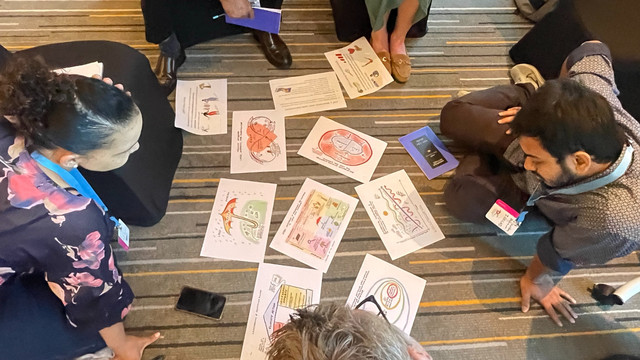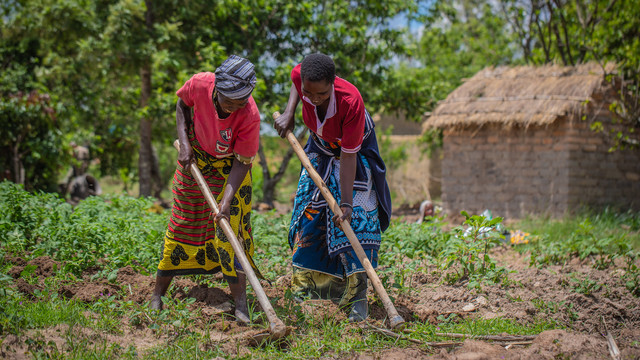Day 2 of Development and Climate Days: Justice, Ethics and Humanitarian Issues
Images of men, women and children in the South wading waist-deep in water or walking stoically through arid wasteland are everywhere in the Northern media now. So in the relative security of the developed world, many are aware that climate change is breaking lives apart.
But many also fail to carry that thought through to its logical conclusion: millions on the move, with no safe haven at the end of the road.
And despite all the Sturm und Drang generated by this conference,that message remains muffled for some.
‘Climate Change and Migration: Transformations or humanitarian crises?’ — a session on Day 2 of IIED’s D&C Days — was a timely reality check. A number of people in the audience ‘told it like it is’ in Bangladesh, the world’s most climate-vulnerable country, where sea level is rising by 7 millimetres a year.
Forced out
‘Bangladesh is our country and we don’t want to leave it,’ said one. ‘But we could be forced out by these shifts. If rich countries drive climate change, and the poor experience the results — the solutions have to come from those who are responsible.’
That might be easier said than done. As the session made clear, many of the people displaced by surging sea levels, drought, fiercer cyclones or erratic rainfall might be surprised to know they occupy the epicentre of a fiery international debate. This hinges on status: how to define people forced to move because of environmental disaster.
That might seem a policy storm in a teacup to some. But anything involving political boundaries and big groups of people in need and in flight demands international regulation.
Of course, the world has an international treaty on refugees. This is the 1951 UN Convention Relating to the Status of Refugees. Broadly, it defines refugees as people who through fear of persecution for ‘reasons of race, religion, nationality, membership of a particular social group or political opinion’ are unwilling to return to their country.
But there is no such treaty offering some kind of security to people who, through fear of losing their homes again to flooding, or seeing their children die in drought-driven famine, or having to fight over forage or land, become displaced within their own country or migrate across borders.
Given the near-future predictions of climate impacts in some of the most impoverished countries of Asia and Africa, what is already happening in Bangladesh, the Sahel and elsewhere is an unmistakeable wake-up call. Not least, because political debate is already erupting over issues such as quotas for climate refugees.
Wide awake
And this was a very wide-awake panel and audience, engaged with the subject and each others’ responses. Chaired by Tom Downing of the Stockholm Environment Institute (SEI) and Jenty Kirsch-Wood of the UN Office for the Coordination of Humanitarian Affairs, the panel included Mo Hamza (SEI), Chella Rajan of the Indian Institute of Technology Madras, Sujatha Byravan of the Centre for Development Finance, and Swedish parliamentarian Tina Aketoft.
Byravan said that we do need something that addresses the rights of people from, say, small island states who have been rendered stateless through climate change. There is, she said, a need for a definition for environmental exiles (those who become stateless) and climate migrants (those who are displaced within their own countries).
That could include internally displaced people — an important point, as the UN Refugee Agency says they currently number some 26 million. More, a growing number are displaced because of environmental issues such as dwindling water supplies. If a treaty is ever drawn up that classifies displaced people as climate migrants and climate exiles, policy decisions would have to abide by two criteria: responsibility and capability on the part of that person.
Space for a treaty
Byravan thought there was ‘space’ for a treaty, but like others reminded that the gears of international politics grind slowly. Setting a treaty up and making it functional can take decades.
Rajan said that if it was numbers that worried policymakers, even 100 million climate exiles over 100 years could be absorbed into host countries. The US influx of legal immigrants can top a million a year. As for the slow-grinding gears, he mentioned the labyrinthine discourse under the Clean Development Mechanism.
‘Trying to identify the most vulnerable people can’t be worse than that,’ he said.
Big issues such as preserving cultural identity, and the plight of urban refugees fleeing drowned coastal cities, were also discussed.
Downing finished by positing two possible headlines. One, ‘Experts agree that there is no need for action on climate change in relation to migration’. the other, ‘One hundred presidents institute agreement on the rights of environmental refugees’.
He added, ‘That uncertainty is the reason to act now, because this process will take twenty years to become effective.’
Other events at Day 2 of D&C Days included sessions on gender and equality, ethical and human rights implications of adaptation policy formation, and population dynamics and climate change. The sixth Up in Smoke report was launched and the nonstop Parallel Film Festival entered Day 2.
The D&C Days go on to the afternoon of Monday December 14 at Copenhagen’s arts centre near the main COP venue, the Koncerthuset (Concert House) at the DR Byen stop on the Metro.



